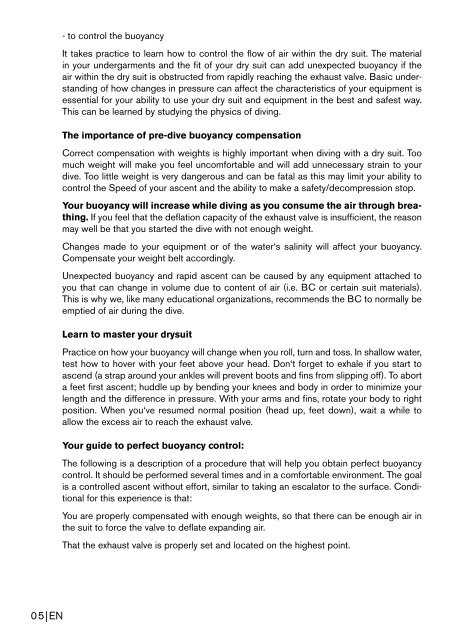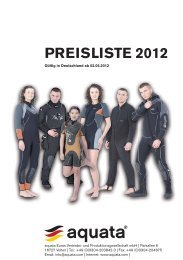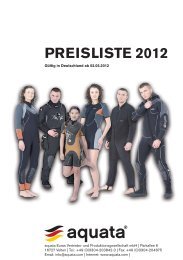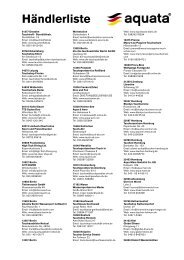GEBRAUCHS- UND PFLEGE- ANWEISUNG FÜR TROCKEN - Aquata
GEBRAUCHS- UND PFLEGE- ANWEISUNG FÜR TROCKEN - Aquata
GEBRAUCHS- UND PFLEGE- ANWEISUNG FÜR TROCKEN - Aquata
Create successful ePaper yourself
Turn your PDF publications into a flip-book with our unique Google optimized e-Paper software.
05|EN<br />
- to control the buoyancy<br />
It takes practice to learn how to control the flow of air within the dry suit. The material<br />
in your undergarments and the fit of your dry suit can add unexpected buoyancy if the<br />
air within the dry suit is obstructed from rapidly reaching the exhaust valve. Basic understanding<br />
of how changes in pressure can affect the characteristics of your equipment is<br />
essential for your ability to use your dry suit and equipment in the best and safest way.<br />
This can be learned by studying the physics of diving.<br />
The importance of pre-dive buoyancy compensation<br />
Correct compensation with weights is highly important when diving with a dry suit. Too<br />
much weight will make you feel uncomfortable and will add unnecessary strain to your<br />
dive. Too little weight is very dangerous and can be fatal as this may limit your ability to<br />
control the Speed of your ascent and the ability to make a safety/decompression stop.<br />
Your buoyancy will increase while diving as you consume the air through breathing.<br />
If you feel that the deflation capacity of the exhaust valve is insufficient, the reason<br />
may well be that you started the dive with not enough weight.<br />
Changes made to your equipment or of the water‘s salinity will affect your buoyancy.<br />
Compensate your weight belt accordingly.<br />
Unexpected buoyancy and rapid ascent can be caused by any equipment attached to<br />
you that can change in volume due to content of air (i.e. BC or certain suit materials).<br />
This is why we, like many educational organizations, recommends the BC to normally be<br />
emptied of air during the dive.<br />
Learn to master your drysuit<br />
Practice on how your buoyancy will change when you roll, turn and toss. In shallow water,<br />
test how to hover with your feet above your head. Don‘t forget to exhale if you start to<br />
ascend (a strap around your ankles will prevent boots and fins from slipping off). To abort<br />
a feet first ascent; huddle up by bending your knees and body in order to minimize your<br />
length and the difference in pressure. With your arms and fins, rotate your body to right<br />
position. When you‘ve resumed normal position (head up, feet down), wait a while to<br />
allow the excess air to reach the exhaust valve.<br />
Your guide to perfect buoyancy control:<br />
The following is a description of a procedure that will help you obtain perfect buoyancy<br />
control. It should be performed several times and in a comfortable environment. The goal<br />
is a controlled ascent without effort, similar to taking an escalator to the surface. Conditional<br />
for this experience is that:<br />
You are properly compensated with enough weights, so that there can be enough air in<br />
the suit to force the valve to deflate expanding air.<br />
That the exhaust valve is properly set and located on the highest point.







